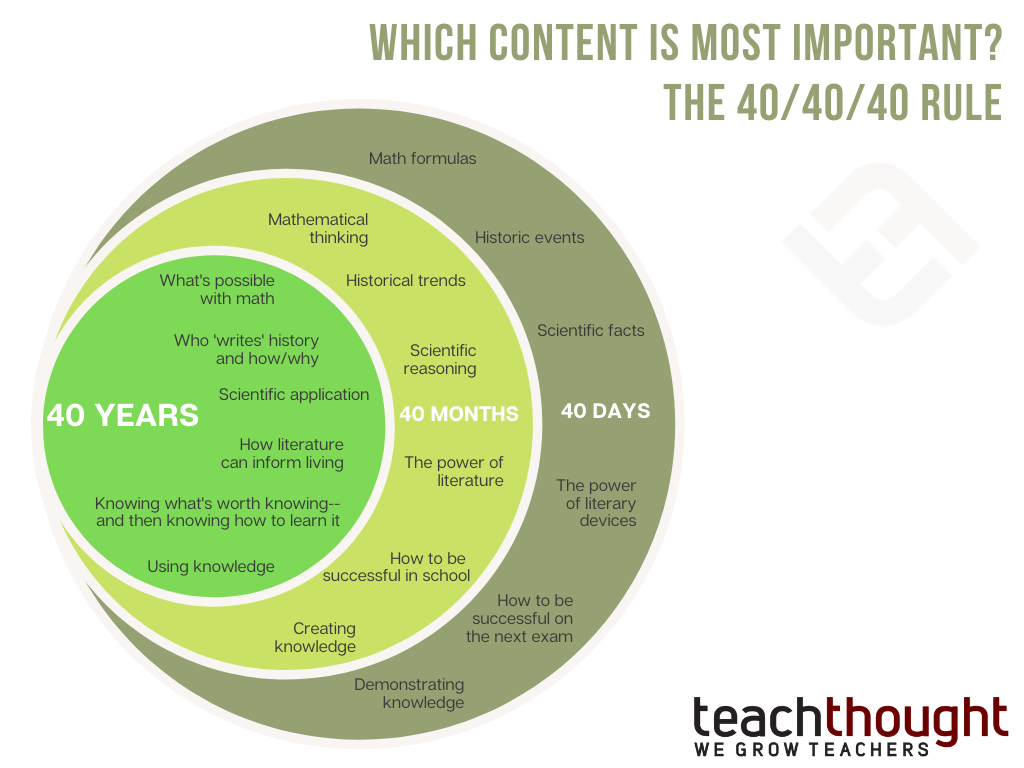Which Content Matters Most? The 40/40/40 rule


with Terry Heick
I first came across the 40/40/40 rule years ago while flipping through one of those great (and important) 400 page Insights into Design tomes.
The question was simple enough. At all levels of education, you are tasked with ‘covering’ (more on this in a minute), what is important for students to understand in the next 40 days, what is important for them to understand in the next 40 months, and what is important for them to understand in the next 40 years?
As you can see, this is a powerful way to think about educational content.
Of course, this leads to a discussion of both power levels and ongoing understanding, curriculum mapping, and instructional design tools that teachers use every day.
But it got me thinking. So I drew a quick pattern of concentric circles–something like the image below–and started thinking about writing process, tone, symbolism, audience, purpose, structure, parts of words, grammar, and a thousand other pieces of ELA stuff.
Not (Required) Power Levels
And it was an enlightening process.
First, note that this process is a little different than identifying energy standards in your curriculum.
Power Levels can be selected by looking at these levels which can be used to ‘anchor and embed’ other content. This “40/40/40” concept is about being able to evaluate a lot of things and quickly see what is needed. If your house is on fire and you have 2 minutes to find more than you can handle, what do you take with you?
In some ways, it can be reduced to a deep versus broad debate. Inclusion versus expertise. UbD refers to it as the difference between “fun to know,” “important content,” and “infinite understanding.” These labels can be confusing—endure versus power standards 40/40/40 vs big ideas vs important questions.
That’s why I love the simplicity of the 40/40/40 rule.
It occurred to me that it’s about making the child the core of the content, rather than just stripping down and organizing the levels. One of UbD’s questions for establishing ‘big ideas’ provides some clarity:
“To what extent does a concept, topic, or process represent a ‘big idea’ that has lasting value beyond the classroom?”
The essence of the 40/40/40 rule seems to be to take an honest look at the content we feed children, and contextualize it in their lives. This points to authenticity, value, and the kind of lifelong learning that educators can only dream of.
Applying the 40/40/40 Rule in Your Classroom
There is probably no single ‘right way’ to do this, but here are a few tips:
1. Start Alone
Although you will need to interact with these team or department members soon, it helps to clarify what you think about the curriculum before the world joins you. In addition, this approach forces you to analyze values closely, rather than simply being polite and nodding your head too much.
2. Then Assemble
After drawing your thoughts about the content standards you teach, share them–online, in a data group or PLC meeting, or with your colleagues one afternoon after school.
3. Keep it Simple
Use a simple 3-column chart or concentric circles as shown above, and start separating the wheat from the chaff. No need to worry about your graphic editor.
4. Be Flexible
You will have a different sense of importance about values than your colleagues. These are different personal philosophies about life, teaching, your content area, etc. As long as the difference is not large, this is normal.
5. Realize Children Are Not Little Adults
Yes, everyone needs to spell correctly, but gauging spelling versus producing vague undertones or themes (common content in English Language Arts) is also a matter of recognizing that children and adults are very different. It is rare for a child to be able to explore a range of media, integrate themes, and create new learning experiences without being able to use action appropriately. It is possible, but therein lies the concept of power standards, big ideas, and very quickly the 40/40/40 rule: One day–40 days. 40 months, or even 10 years from now—the students in front of you will be gone—adults in the “real world.”
Not everything they can do—or can’t do—at that time will be for you no matter how large the study, the experimental design, the use of data, the travel guide, or the curriculum map. But if you can accept that—and start to step back from the worst-case scenario of “if they don’t learn anything else this year, they’ll know this and that—then you can move back from what’s important.”
Those pieces of content that will last 40 years–or more.
In your content area, your curriculum map, travel guide, or any guidance documents you use, fill in that orange circle first and work backwards from there.
Which Content Matters Most? The 40/40/40 rule
Source link



